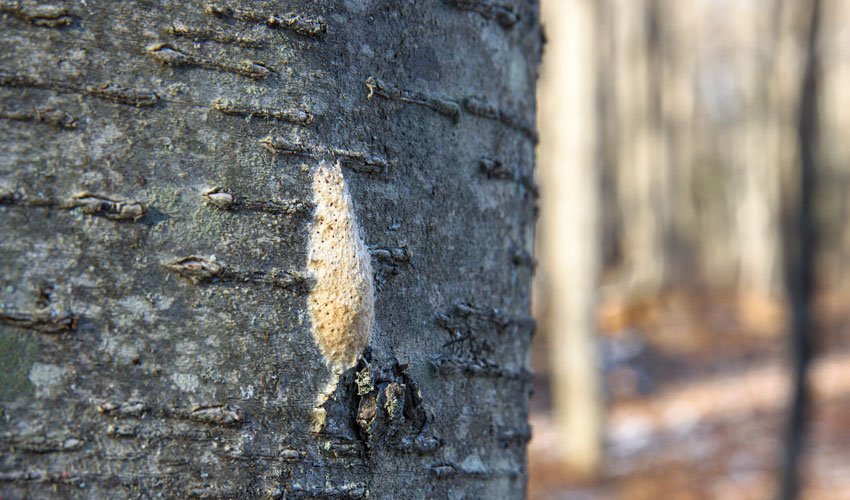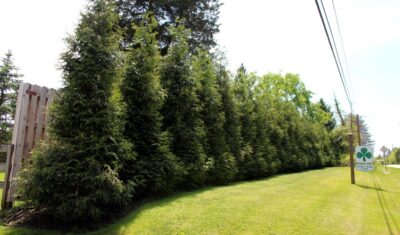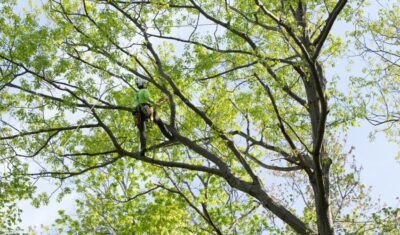Given how cold winters can be in northeast Ohio, you’d think insect pests would be killed by the frigid temperatures. But while some insects (such as wasps, yellowjackets, and crickets) are decimated by the cold, many others manage to survive the deep freeze.
And when spring arrives, they’re ready to start breeding and eating your plants!
That’s why winter is a good time to inspect your trees, shrubs and landscape plants for evidence of overwintering insect pests. By identifying problems before the pests emerge in spring, you can prevent the situation from getting worse.
How do insects survive winter?
Different insect species have different strategies for getting through the winter cold. Here are some of the many ways bugs manage to survive a northeast Ohio winter.
Migration
The most commonly known example of this is the Monarch butterfly, which heads south in the fall to avoid the freezing temperatures. Not all butterflies migrate south though – the mourning cloak butterfly stays put, sheltering in tree cracks or small crevices in rocks. Other butterfly species spend the winter as chrysalids suspended from dead sticks and stems. And smaller bugs, especially those that don’t fly, simply cannot migrate.
“Hibernation”
Many insects survive by going into diapause, a hibernation-like state in which they appear to be dead. While in this state, they temporarily stop all growth and development, although their metabolic rate is just high enough to keep them alive.
If you warm up an insect that’s in diapause, you’ll see it slowly come back to life. That’s what happens as temperatures rise in spring and insects seem to appear out of nowhere.
Antifreeze
Almost all insect species produce glycerol, which lowers the freezing point of bodily fluids to prevent fatal ice crystals from forming in their bodies. It’s the same concept as putting antifreeze in your car in winter.
Different insects can withstand different minimum temperatures. Generally speaking, the colder the weather, the fewer the number of species that can survive. For example, hemlock wooly adelgid adults can successfully overwinter on hemlock branches as long as temperatures don’t dip below about -5 F, but the destructive emerald ash borer can survive down to -30 F!
Freezing
A few insects can actually freeze and still survive. Here in Ohio, the goldenrod gall fly survives the winter by finding a dry place to shelter while arctic temperatures turn it into a bugcicle.
Finding Shelter
Adult insects often seek shelter in protected and/or warmer spots, such as tree holes, under logs, in leaf litter, under bark, or underground.
Others search out the warmth of our homes. If you’ve ever been swarmed by Asian lady beetles, boxelder bugs or brown marmorated stink bugs who have invaded your house in fall, you’re very familiar with this method of surviving chilly weather!
Staying Active
Surprisingly, some species remain active throughout the winter. For example, honeybees form a cluster around their queen in the center of their hive, vibrating their wing muscles to stay warm and using stored honey for energy (up to 30 lbs of it!). And some dragonflies, mayflies, and stoneflies spend the winter as nymphs, actively feeding in ponds and streams until they emerge as adults in the spring.
Overwintering as Eggs
Winter is a good time to see egg masses laid in fall. For example, praying mantis egg cases can be easily seen on bare stems. Egg masses from insect pests can also be seen, such as the eggs of viburnum leaf beetles, tent caterpillars, aphids, bagworms, and gypsy moths. Grasshoppers and crickets also leave cold-resistant eggs to hatch when spring arrives.
Overwintering as Larvae
Many destructive pests survive the winter as larvae (grubs or caterpillars). For example, Japanese beetle grubs burrow deep into the soil where temperatures are more moderate. Bronze birch borer and juniper borer larvae overwinter under tree bark.
Check For Pest Issues Before Spring Arrives
Winter is a good time to scout for pest issues because many problems can be more easily seen at this time of year.
Without leaves, certain signs are more obvious in winter, such as the exit holes caused by bronze birch borer, as well as dogwood, juniper and arborvitae borers. Viburnum leaf beetle egg masses are easier to see, scale insects stand out against the bark, and fireblight diseased branches are evident.
Early identification of insect and disease problems is critical for optimum control and allows us to prevent damage from occurring. By checking landscape plants and trees now, any issues can be taken care of or planned for before temperatures rise in spring.
So take some time this winter to get up close and personal with your trees, shrubs, and perennials. You may be surprised at how many insects are hiding in plain sight.
And, of course, you can always call us in to do a professional inspection for pest and disease issues. We can then put together a plan to address those issues before they cause any damage to your landscape.
Schedule a Property Inspection
If you are concerned that your trees may be suffering from insect pests, contact Independent Tree to schedule a property inspection. Our plant health care professionals can check for any insect pest (or disease) issues and recommend next steps to treat or prevent any problems.Recent Articles
Topics
About The Author

STAY IN THE LOOP
WITH OUR
LATEST UPDATES
"*" indicates required fields







